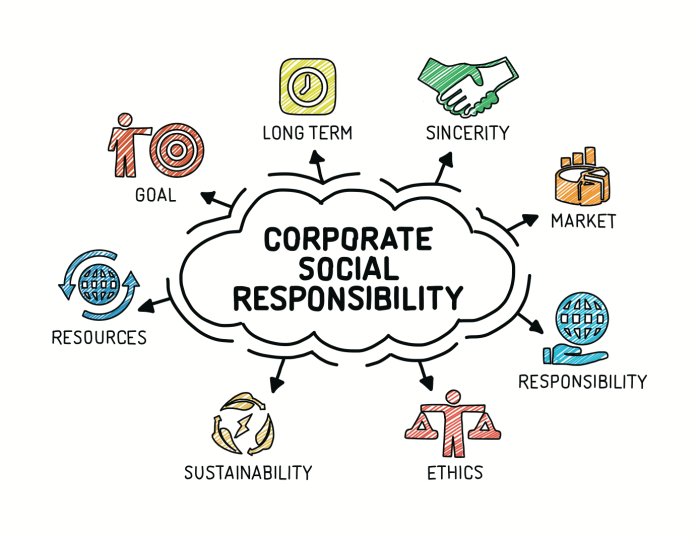Corporate social responsibility is all the rage these days, with companies striving to make a positive impact on society while boosting their own reputation. Picture this: businesses taking the lead in social and environmental initiatives, creating a win-win situation for everyone involved.
From defining CSR to exploring its benefits and challenges, this guide dives deep into the world of corporate social responsibility, shedding light on why it matters now more than ever.
Definition of Corporate Social Responsibility
Corporate Social Responsibility (CSR) in the business context refers to a company’s commitment to operate in an economically, socially, and environmentally sustainable manner. It involves taking responsibility for the impact of their activities on customers, employees, communities, and the environment.
Examples of CSR Initiatives
- Donating a percentage of profits to charitable organizations
- Implementing environmentally friendly practices, such as reducing waste and carbon emissions
- Supporting local communities through volunteer programs and donations
- Ensuring fair labor practices and employee well-being
Importance of CSR for Businesses and Society
- Enhances company reputation and brand image
- Attracts and retains customers who value ethical practices
- Increases employee morale and engagement
- Contributes to sustainable development and social welfare
Benefits of Corporate Social Responsibility

Corporate Social Responsibility (CSR) initiatives offer numerous advantages for companies looking to make a positive impact on society while also benefiting their bottom line. By engaging in CSR activities, companies can enhance their brand reputation, build customer loyalty, and contribute to long-term sustainability and profitability.
Improved Brand Reputation
- CSR activities help companies showcase their commitment to social and environmental causes, leading to a positive perception among consumers and stakeholders.
- Positive brand reputation can differentiate a company from competitors and attract socially conscious customers who prefer to support businesses that give back to the community.
- Enhanced brand reputation can also lead to increased customer trust and loyalty, as consumers are more likely to support companies that demonstrate ethical and socially responsible behavior.
Customer Loyalty
- Companies that engage in CSR initiatives often build strong emotional connections with customers who share their values, leading to increased customer loyalty and repeat business.
- By aligning their CSR efforts with customer preferences and societal needs, companies can create a sense of purpose that resonates with consumers and fosters long-lasting relationships.
- Customer loyalty resulting from CSR activities can lead to higher customer retention rates, increased customer lifetime value, and positive word-of-mouth recommendations, ultimately driving business growth.
Long-Term Sustainability and Profitability
- CSR initiatives that prioritize environmental sustainability and social responsibility can help companies mitigate risks associated with climate change, resource depletion, and social inequality, ensuring long-term business viability.
- By investing in sustainable practices, companies can reduce operational costs, improve efficiency, and attract environmentally conscious investors and partners who value responsible business practices.
- Long-term sustainability efforts not only benefit the planet and society but also contribute to the financial success of companies by fostering innovation, resilience, and long-lasting relationships with stakeholders.
Key Components of Corporate Social Responsibility Programs

Corporate Social Responsibility (CSR) programs are designed to integrate social and environmental concerns into a company’s business operations. These programs are essential for businesses to demonstrate their commitment to sustainable practices and ethical behavior. Let’s explore the key components that make up a comprehensive CSR program.
Environmental Initiatives, Corporate social responsibility
- Implementing sustainable practices to reduce carbon footprint.
- Investing in renewable energy sources.
- Reducing waste and promoting recycling programs.
Social Responsibility
- Supporting community development projects.
- Promoting diversity and inclusion within the workforce.
- Ensuring fair labor practices and ethical sourcing of materials.
Economic Impact
- Creating job opportunities in local communities.
- Investing in education and skills development programs.
- Supporting small businesses and suppliers through fair trade practices.
Successful CSR Programs Examples
- Patagonia: Known for its commitment to environmental sustainability through initiatives like the “Worn Wear” program, promoting the repair and reuse of clothing.
- TOMS: By implementing a “One for One” model, TOMS provides a pair of shoes to a child in need for every pair sold, addressing social issues like poverty and education.
- Microsoft: With programs like YouthSpark, Microsoft aims to empower young people through technology education and skill-building, contributing to economic development.
Challenges in Implementing Corporate Social Responsibility
Implementing Corporate Social Responsibility (CSR) initiatives can pose various challenges for companies. These challenges often stem from balancing the financial interests of the company with the social and environmental responsibilities it aims to fulfill. Companies may face obstacles such as resistance from stakeholders, lack of resources, and difficulty in measuring the impact of CSR programs.
Obstacles in Implementing CSR Initiatives
- Resistance from stakeholders: Some stakeholders may prioritize short-term profits over long-term sustainability, making it challenging to garner support for CSR initiatives.
- Lack of resources: Implementing effective CSR programs requires financial investments, time, and expertise, which some companies may struggle to allocate.
- Difficulty in measuring impact: Quantifying the social and environmental impact of CSR initiatives can be complex, leading to uncertainty about the effectiveness of these programs.
Risks Associated with Inadequate CSR Practices
- Reputation damage: Companies that neglect CSR may face backlash from consumers, investors, and the public, leading to tarnished reputation and loss of trust.
- Legal issues: Non-compliance with CSR regulations can result in fines, lawsuits, and legal troubles, impacting the financial stability of the company.
- Missed opportunities: Companies that do not prioritize CSR may miss out on potential business advantages, innovation opportunities, and competitive edge in the market.
Strategies to Overcome Challenges in CSR Implementation
- Engage stakeholders: Communicate the benefits of CSR initiatives to stakeholders and involve them in the decision-making process to gain their support.
- Allocate resources effectively: Prioritize CSR investments based on impact assessment and allocate resources strategically to maximize the benefits of these programs.
- Measure impact and adjust: Implement robust monitoring and evaluation mechanisms to track the outcomes of CSR initiatives, allowing for adjustments and improvements as needed.
Corporate Social Responsibility Reporting
Corporate Social Responsibility (CSR) reporting plays a crucial role in showcasing a company’s commitment to social and environmental issues. By reporting on CSR activities and their impact, companies can transparently communicate their efforts to stakeholders and the public.
Importance of Reporting on CSR Activities and Impact
- Provides transparency: CSR reports allow companies to be transparent about their social and environmental initiatives, demonstrating accountability to stakeholders.
- Builds trust: Reporting on CSR activities helps build trust with customers, investors, employees, and the community by showcasing the company’s commitment to making a positive impact.
- Drives improvement: Through reporting, companies can identify areas for improvement in their CSR strategies and work towards enhancing their social and environmental performance.
Common Frameworks and Standards for CSR Reporting
- Global Reporting Initiative (GRI): One of the most widely used frameworks for CSR reporting, GRI provides guidelines for companies to report on their economic, environmental, and social impacts.
- UN Global Compact: Companies can align their CSR reporting with the UN Global Compact’s Ten Principles encompassing human rights, labor, environment, and anti-corruption.
- Sustainability Accounting Standards Board (SASB): SASB standards focus on material sustainability issues specific to various industries, guiding companies in reporting relevant CSR information.
How CSR Reports are Used by Stakeholders
- Investors: CSR reports help investors evaluate a company’s long-term sustainability and ethical practices, influencing investment decisions.
- Consumers: Consumers increasingly prefer to support companies with strong CSR commitments, using CSR reports to make informed purchasing choices.
- Employees: CSR reports can attract and retain talent by showcasing a company’s values and commitment to social responsibility, improving employee engagement.





